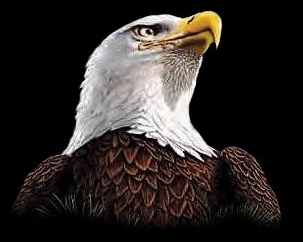 |
 |
|
Eagle Feathers Eagle Medicine is the power of the Great Spirit, |

|
Eagle feathers are considered infinitely sacred to traditional Native American people who make use of the feathers for a variety of purposes including ceremonial healing and purification. Eagle Medicine represents a state of presence achieved through diligence, understanding, awareness, and completion of "test of initiation" such as the vision quest or other demanding life experiences. Elder status is associated with Eagle Medicine and the power of connectedness and truth, It is through the wisdom of experience that this Medicine is earned. The Eagle feather, which represents duality, tells the story of life. It tells of the many duality's that exist in life, such as light and dark, male and female, substance and shadow, summer and winter, peace and war, life and death. It reminds us of the teachings that Opposites are extensions of themselves like two opposing hands of the same body. Native American traditionalists look upon the Eagle feather as a sacred symbol of the balance necessary for the Circle of life to continue. J. T. Garrett, as a member of the Eastern Band of Cherokee, describes how: The Eagle feather teaches us about the Rule of Opposites, about
everything being divided into two ways. The more one is caught up in
the physical, or the West, then the more one has to go in the opposite
direction, the East, or the spiritual, to get balance. And it works
the other way, too- you can't just focus on the spiritual to the exclusion
of the physical. The Lesson of Opposites is that of choice. Any two Opposites are often part of the same truth. If we consider the Eagle feather with its light and dark colors, we could argue that "the dark colors are far more beautiful and, therefore, naturally more valuable," or vice versa. Regardless of which colors are said to be more beautiful, or necessary, or valuable, the truth is the bottom line: Both colors come from the same feather, both are true, they are connected, and it takes both to fly. The balance of which the traditional way speaks is not a
recognition of two separate phenomena, nor a decision as to which is best
and which is worst. The balance of which the traditional way speaks is
worst. The balance of which the traditional way speaks is a
recognition of the "oneness" of two differing phenomena, and a decision to
honor both through harmony and balance. Traditionally, a
person earns the Eagle feather through enormous acts of courage,
understanding, or generosity.
The Lesson of the Eagle There are certain animals, birds, and water beings that are referred to in Native American stories. Probably none of them have been as honored as the bald eagle. To Native Americans, it is considered as possibly the most sacred bird. The turtles of the sea and land also seem to have special significance in stories. Cherokee stories relate to the turtle as having a special purpose since the beginning of time. The turtle shells were worn by the Cherokee female dancers in earlier Green Corn ceremonies and today in Stomp Dancers and pow-wows. The importance of the Eagle Dancers among the Cherokee and the use of eagle feathers by other Native Americans today attest to the honor given to the eagle. The Eagle Dance among the Cherokee represents a strength and power to be honored. Unfortunately, while tens of thousands of eagles were once in North America, they now are rarely seen. In 1782 - the year the bald eagle was formally adopted as our national emblem - bald eagles were probably flourishing, with as many as 20,000 nesting pairs in what is now the United States. In the 200 years since the bald eagle became our symbol of strength and freedom, its numbers have suffered a great decline. By the late 1800's bald eagles were already restricted to their current breeding stronghold: Alaska, Canada, the Great Lakes States and the Pacific Northwest. At one time there were only 3,000 nesting pairs in the lower 48 states. Since then, the bald eagle has recovered dramatically from the lower numbers of the 1960's and 1970's. Today there are more than 10,000 nesting pairs in the lower 48 states. In 1995, the bald eagle's status was downgraded from endangered to threatened throughout this range. To the surprise of most people Missouri is one of the leading bald eagle states. Each fall, thousands of these great birds migrate south from their nesting range in Canada and the Great Lakes States to hunt around the open waters of our rivers and lakes. Many take up residence wherever they find open water and plentiful food. Missouri, because of its big rivers, many lakes and wetland areas, is especially attractive to these huge, magnificent birds. More than 2,200 bald eagles were reported in Missouri during a recent winter, making our state the leader in the lower 48 states. Information taken from Medicine of the Cherokee, by J. T. and Michael Garrett, and Missouri Department of Conservation. Because of the layout of this site, To make it easier
|